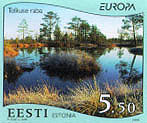Surrounding Endla Lake is a complex of bogs, fens, streams and small lakes. The present Endla Nature Reserve was created in 1985; it includes seven bog complexes. Among these, Männikjärve bog has been the site of scientific investigations since the early 1900s, and a meteorologic station is located there. An elevated, wooden walkway allows visitors to travel across the bog without disturbing the surface and without sinking into the peat and mud. As a scale reference in the photos, this walkway is about 60 cm (2 feet) wide. We performed kite aerial photography in late summer (September) and early autumn (October) from the wooden platform at the meteorologic station in Männikjärve bog on the eastern side of the Endla bog complex.

| View toward the northwest across Männikjärve bog. The bog center is seen toward the left. It's marked by elongated peat hummocks with intervening narrow water pools. The path is an elevated wooden walkway for visitors. Kite fliers are working from a small meteorologic station in lower part of view. Photo date 9/00, © J.S. Aber. |

| View toward the north. The bog surface (left) has a corrugated appearance due to peat hummocks. The forest margin can be seen in the distance and to the right. Photo date 9/00, © J.S. Aber. |

| View to the southwest with sun glint from water surfaces. The bog center is visible in the middle distance, and Endla Lake appears in the far left. Photo date 9/00, © J.S. Aber. |

| Closeup, low-oblique view of the bog-forest margin. Sun glint shows small water pools in the bog, and a trail is faintly visible running toward the upper left corner of view. Photo date 9/00, © J.S. Aber. |

| Männikjärv (lake) is situated on the eastern edge of the bog complex. It's in the first stage of bog development, as aquatic vegetation fills in around the margin of the lake basin. Photo date 9/00, © J.S. Aber. |

| View toward the southeastern margin of Männikjärve bog with the kite flyers at the small meteorologic station. Photo date 10/00, © J.S. Aber. |

| Southeastern edge of the bog with a transitional pine forest around Männikjärv (lake).
Photo date 10/00, © J.S. Aber. |

| View westward over the central portion of Männikjärve bog. The observation tower is visible on the boardwalk in left-center of view. Photo date 10/00, © J.S. Aber. |

| Low-oblique view westward of the wooden walkway near center of bog. The boardwalk stands about 60 cm (2 feet) above the surface of the bog and is supported by wood posts driven into the peat. Photo date 10/00, © J.S. Aber. |

| Sun glint highlights standing water in pools next to the boardwalk in this low-oblique view toward the southwest. The observation tower is visible in the extreme upper right corner of scene. Photo date 10/00, © J.S. Aber. |

| Vertical view over boardwalk. Dwarf pines grow on hummocks between hollows. Water forms a pool in a hollow at top of view; other hollows are shown by outlines of orange-colored moss. Photo date 10/00, © J.S. Aber. |

| Another vertical view in which a small, circular pool is visible at scene center. Photo date 10/00, © J.S. Aber. |

